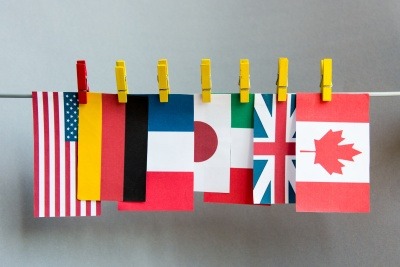WRAP: G7 could save 0.8 billion tonnes of CO2eq emissions
Global climate action NGO WRAP has produced its ‘Seven Steps Towards Net Zero’ report for the G7, calling on its nations as well as all other countries to monitor and reduce their ‘consumption-based emissions alongside their territorial emissions’.
 Through its report, WRAP aims to address the ‘massive volume’ of greenhouse gases linked to consumption, which currently pass unchecked into the atmosphere every year.
Through its report, WRAP aims to address the ‘massive volume’ of greenhouse gases linked to consumption, which currently pass unchecked into the atmosphere every year.
Setting out seven strategies that can be adopted across government, business, and civil society at an international level, the NGO offers a framework for how G7 members – Canada, France, Germany, Italy, Japan, UK and USA – can ‘effectively reduce consumption-based emissions through resource efficiency’. These preventative measures are applicable for governments and businesses ‘across all nations’.
Earlier this year, WRAP expressed support for the G7’s announcement that it would increase its focus on making resource efficiency and circular economy ‘the norm’ – as well as proposing sustainable consumption and production models. Especially, WRAP says, as G7 countries currently control or influence 27 per cent of all global emissions.
Examining the differences between territorial and consumption-based emissions within G7, the NGO found that 1.8 billion tonnes of greenhouse gas (GHG) emissions (measured in Co2eq) are being missed. WRAP estimates that this ‘failure’ is due to the current focus on ‘territorial emissions’ and not equally on consumption-based emissions.
Notably, countries that import a high proportion of foods, goods, and services fail to measure and report the emissions embedded in those imported goods – the report highlights that for this reason, they are currently not captured or counted and become ‘impossible to address’.
WRAP’s ‘Seven Steps’ supports reductions in both territorial and consumption-based emissions. If implemented, G7 countries could avoid between 300 and 1,800 million tonnes CO2e per year by 2030, with a central estimate of 800 million tonnes CO2e when implementing all recommendations fully.
The seven strategies fall under three categories – transforming food systems, making products last longer and changing material use. This structure also details the potential greenhouse gas emission reductions possible against three scenarios from a ‘low impact, a central and a transformative scenario’ with a radical change in levels of consumption.
‘Transforming food systems’
Presenting the food system as a primary contributor to GHG emissions, WRAP urges food businesses to commit to meeting the United Nations target to halve their food waste by 2030. It suggests that this is achievable through a ‘Target, Measure, Act’ approach – ‘working with the entire supply chain from farm to fork’.
Food production currently contributes 37 per cent of global greenhouse gas emissions. WRAP says that this could be reduced in three ways – cutting emissions from food production (regenerative agriculture), changing the types of food we produce and eat and reducing food waste.
It is suggested that G7 looks toward a low-impact scenario involving a 40 per cent reduction in food waste from retail and citizens, which may yield an estimated saving of 60 million tonnes CO2e per year.
To meet UN SDG 12.3, and therefore save 76 million tonnes CO2e per year, WRAP also recommends that governments redouble their efforts to tackle food waste. Further, a transformative scenario would see 370 million tonnes CO2e saved per year.
‘Making products last longer ‘
Through a change in attitudes and behaviours to enforce better use of products and increase how long they can last, G7 countries could save ‘nearly 800 million tonnes CO2e per year by 2030’. WRAP says that behaviours such as re-use, repair, refurbishment and remanufacture should be advocated within businesses – this shift in business models could allow G7 to avoid 255 million tonnes of CO2e per year.
‘Changing materials’
Lightweighting and the use of low carbon or recycled materials are presented by WRAP as being able to save G7 countries around ‘250 million tonnes CO2e per year by 2030’.
For example, designing lightweight products, recycling more domestically and substituting materials – by swapping highly carbon-intensive materials (such as steel and cement), from which products are made, for lower-carbon-intensity alternatives (such as wood and other biomaterials).
The Paris Agreement
An underlying warning of WRAP’s report is the risk of missing the Paris Agreement, to keep global warming below 1.5°C. To meet it, the world needs to halve annual greenhouse gas emissions by 2030, reaching peak emissions by 2025.
This will not happen, WRAP alerts, if the following does not happen:
- All countries, particularly G7, measure and act on emissions from imported goods that are generated along with global supply chains (consumption-based emissions).
- All countries include actions to reduce food waste in their Nationally Determined Contributions (NDCs) submitted to all future COPs, and support businesses and individuals to change the way they produce and consume goods and services. This helps them to reduce territorial emissions.
- All businesses work with suppliers and partners to set and commit to deliver GHG targets in line with 1.5°C, including their scope three emissions.
A ‘blueprint for those nations to implement the promises they have made’
Marcus Gover, WRAP CEO, said: “Actions by every citizen on Earth are fuelling this climate emergency, and Governments need to move faster in acting on consumption-based emissions. The G7 members alone are currently falling short by nearly two billion tonnes of GHG emissions every year in terms of consumption-based emissions.
“Our report is the blueprint for those nations to implement the promises they have made, and we look forward to supporting them in doing so.”
Clementine O’Connor, UNEP Programme Management Officer for Sustainable Food Systems, added: “G7 countries waste 91 million tonnes of food annually or almost 10 per cent of all food wasted globally. Yet, effective action is possible. For example, the UK has reduced food waste by 27 per cent per capita since 2007, beating a path towards successful delivery of SDG 12.3.
“With food loss and waste generating eight to ten per cent of global greenhouse gas emissions, it is urgent to embed food loss and waste reduction in NDCs and net zero pathways and highlight the contribution of consumption-based emissions.”




